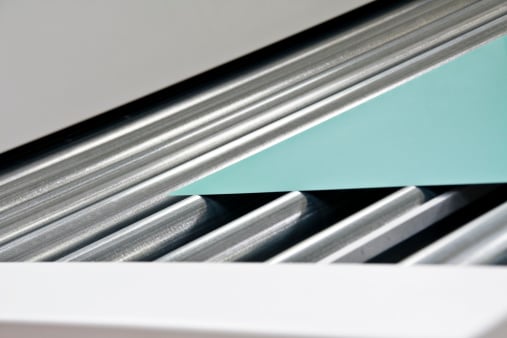Although cutting-edge commercial printing companies are transitioning to digital printing, many printers continue to rely on the tried-and-true offset printing technology, which has been the industry standard for more than a century.
And understanding the print production process can be incredibly beneficial in preparing specific design components to aid in the production of a high-quality print result. Separating your final artwork into CMYK and any spot colors to make printing plates is one such step. Today, we'll look at what Printing Plates are, how they're manufactured, and what part they play in the print manufacturing process when it comes to creating full-color images.
Offset Printing Technology
Offset printing transfers an image to paper or other media using printing plates. Plates are typically constructed of a thin sheet of metal, although they can also be made of plastic, rubber, or paper. Metal plates are more expensive than paper plates, but they endure longer, generate higher-quality images on paper, and are more accurate than alternative materials.
During the prepress step of production, an image is "burned" on a printing plate using a photomechanical or photochemical process. Each color of ink in the print job requires its own plate.
Printing plates are linked to the printing press's plate cylinders. Rollers are sprayed with ink and water. The image on the plate is transferred to an intermediary cylinder, then to the plate, where the ink only adheres to the pictured parts of the plate. The ink is then transferred to the paper as it passes through the press.
Decisions on Prepress Plating
A single plate is required for a print job that uses solely black ink. A print job that uses both red and black ink necessitates the use of two plates. In general, the higher the price, the more plates need to print a project.
When color photos are involved, things grow more difficult. Colored images must be separated into four ink colors for offset printing: cyan, magenta, yellow, and black. The CMYK files are eventually converted into four plates that run on the printing press simultaneously on four cylinders. The CMYK color model differs from the RGB color model displayed on your computer screen. Every print job's digital data are checked and changed to reduce the number of plates required to print the project and to convert color images or difficult files to simply CYMK.
There may be more than four plates in rare circumstances. Additional plates are required if a brand must appear in a specific Pantone hue or if metallic ink is utilized in addition to full-color graphics.
Artwork that is Print-Ready
Each CMYK primary color, Cyan, Magenta, Yellow, and Black, is separated in the file. Additional plates are created when spot colors, such as metallics, or Spot Machine Varnishes, are utilized. Full-color graphics are produced by printing four CMYK colors on top of one another.
Plate Placement
The images are subsequently transferred onto aluminum plates, one plate for each color, utilizing a Plate Setter Machine using these color-separated files. Many Plate Setting techniques involve the use of chemicals, water, and gums.
Printing with an Offset Press
When the final plates are removed from the Plate Setting Machine, the images are off-white and scarcely visible until they are placed on the printing press and come into contact with the ink.
The plates are put into their matching color station on the press and wrapped around the plate cylinder. There are three cylinders inside the press: Plate Cylinder, Blanket Cylinder, and Impression Cylinder.
This inked image is then transferred to the Blanket Cylinder as the paper substrate goes through between the Blanket Cylinder and the Impression Cylinder while the Plate Cylinder revolves. The image is built as the paper passes through each of the CMYK color stations.
This is why it is named "Offset" printing because the paper does not come into direct contact with the plate cylinder, but rather is moved from the plate to the blanket, to the paper, forming the image one color at a time.
What Happens to the Plates Once the Printed Project is Completed?
Fortunately, printing plates are created from the purest form of aluminum and are indefinitely recyclable because they are not used for long periods of time or have a complicated shape. For many years, commercial printers around the world have recycled their printing plates, contributing to the circular economy.
Cost of Plate Imposition
Several copies of the file may be printed on a large sheet of paper and then trimmed to size depending on the size and quantity of the finished printed output.
When a print project requires printing on both sides of a sheet of paper, the prepress department may impose the image to print all the fronts on one plate and all the backs on another, a technique known as sheetwise imposition. When the paper has a different texture on one side than the other, or the print job comprises of the same fronts with numerous versions of the back, this imposition is employed.
Other Plate Designs
The screen is the equivalent of the printing plate in screen printing, a popular method for printing on fabrics. It is commonly a porous cloth or stainless steel mesh stretched over a frame and can be made manually or photochemically.
Paper plates are often only suited for short print runs with no close or touching colors that necessitate trapping. If you want to save money, plan your design such that paper plates may be used successfully. This low-cost option is not available from all business printers.
Henan Huida Print-All has been a specialized and large-scale printing plate manufacturer since 2003. Years of providing our clients with high-quality print, magazine, newspaper, offset, and logistical services. We'd love to collaborate with you as well.
Contact us to discuss your next project.

